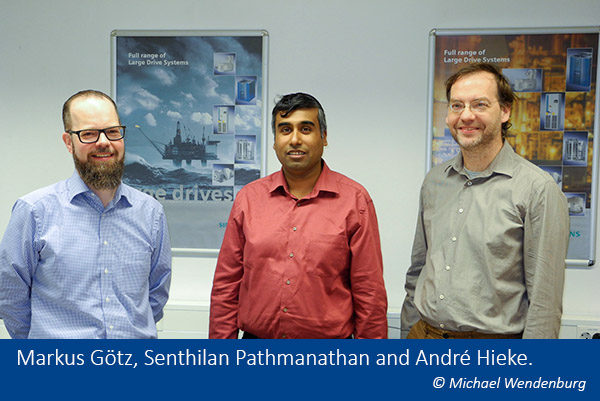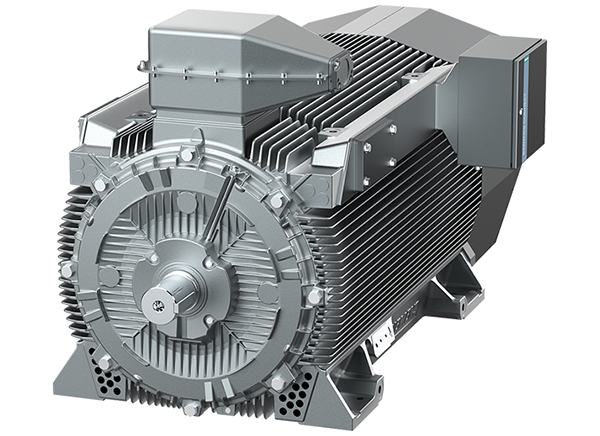
|
PDF Generator 3D as the motor driving the product configuratorBy Harald Blümel At Siemens Large Drives Applications, variance is a competitive advantage. The Siemens company manufactures heavy-duty electric motors and converters for industrial and special drives in batch sizes that tend toward one. With the help of PROSTEP's PDF Generators 3D, the company is able to automatically provides its customers with the offer documents for their product configurations, including the 3D models, from the cloud. Siemens Large Drives Applications (LDA) is one of the Siemens Group's oldest and largest portfolio companies (PC). With a workforce of around 4,900 employees worldwide, the PC develops, manufactures and sells high-voltage motors as well as medium-voltage converters and generators. The products are used in ship propulsion systems and in a large number of industrial applications, e.g. on drilling platforms, in pipelines, in the energy and water supply sectors, and in rolling mills and cement works. Siemens LDA is headquartered in Nuremberg, Germany, and has development and production sites in six countries and all the time zones around the world. It is rare for the products to built in their entirety at a single site; instead they are usually produced in the local factories. The design engineers at Siemens LDA use NX, the 3D CAD system from its sister company Siemens Software, to develop new motors and converters. They manage their mechanical components with the PLM system Teamcenter, where the electrical and electronic components are also stored. The motors are equipped with a growing number of sensors and analysis components, which are used to monitor vibrations, temperatures and other parameters and to offer customers data-based services like predictive maintenance. It is therefore increasingly important that service engineers know the exact construction status of the products actually delivered, so that they can make sure to take the right spare parts with them when servicing is required. Need for action in the presales process Almost no two motors or inverters that Siemens LDA delivers are alike. Taking account of customer-specific requirements provides the company with a key competitive advantage. Although the products can be configured to a very large extent, they normally still need a certain amount of engineering, which flows back into the configuration options if possible. "This means that we can now map a large proportion of special requests via the configurator," says Markus Götz, Siemens LDA PLM IDS Processes and Tools. The drive technology configurator (DTK) is available to customers in Siemens' Industry Mall. As IT project manager André Hieke says, implementation of the next generation product configurator means that Siemens LDA has, for the first time, created the basis for mapping delivered products in their entirety in 3D. The initial focus of the Next Generation Sales Visualization project was improving the presales process. There was a particular need for action when it came to preparing the 3D models and 2D drawings, which are made available to customers together with the offers to ensure that they can use the motors in their planning tools. The NX data was re-modeled in an extremely simplified form using CADClick software for visualization in the DTK and configuration logic was added, which required a lot of time. "But the worst thing was that the high level of variance in our products meant that our colleagues were constantly having to reproduce things," says designer Senthilan Pathmanathan. 
The aim of redesigning the configurator was to eliminate use of the third-party system and make the documents available automatically from NX or Teamcenter. This meant that the 3D models of the individual parts needed to be derived in simplified form and linked with each other using configuration rules, so that the assemblies could be developed dynamically and converted into a neutral format. The dimension sheets containing the dimensions of the motors were also to be generated automatically and made available together with the 3D models. "The biggest challenge for us was the fact that dynamic preparation and conversion of the 3D models shouldn't take more than a minute," says Hieke. Combination of 3D and 2D data At Siemens LDA, the configuration logic is not mapped in Teamcenter. The manufacturing BOMS are configured in the SAP variant configurator, which is also familiar with relationships between the components but not their exact position and location. This information is now stored in Siemens' Rulestream software regardless of whether the CAD geometry has been generated or not, says Götz. This means that configuration is possible irrespective of whether or not the design of the component involved has been finalized. In addition, new components and options can be very quickly introduced in the configurator. One of the formats suitable for providing the documents that make up an offer was 3D PDF. There was some initial concern due to the fact that additional software was required to convert the NX or JT data since the CAD software does not provide direct conversion support. As far as the sales staff were concerned, the format offered the advantage that they could view it using the standard Adobe Reader without having to install a special viewer. As Götz says, PDF Generator 3D impressed the project team, first and foremost with its ability to integrate PMI information in the 3D PDF documents and combine 3D models with 2D documents. This also makes the solution interesting for other use cases such as drawing-free manufacturing and the provision of service documentation. The fact that the PROSTEP solution could be seamlessly integrated in the existing process chain was also important. The experts from the PLM consulting and software company needed less than a week to execute the technical part of the implementation, set up the workflows and create the templates for visualizing the 3D PDF documents. They include not only the 3D models but also predefined 2D views with the PMI dimensions, which are, so to speak, replicated in the drawings. "The solution was practically ready for use before it was even officially commissioned," says Hieke. The processes did, however, have to be optimized due to the fact that the short generation and loading times placed extremely high demands on the performance of the entire infrastructure. 
Generating 3D PDFs from the cloud Since the configurator runs in the Internet, Siemens LDA decided to also provide the CAD generation and conversion services from the cloud. Both Rulestream and NX are installed on three application servers hosted at Amazon Web Services (AWS). Load balancers ensure even load distribution when generating the CAD assemblies and providing the various neutral formats. Siemens LDA offers its customers a number of different options, all of which are generated using the same process. 3D PDF conversion runs on a separate server, which is used by the three application servers. The cloud infrastructure can be scaled up to four CPU cores and is completely virtualized. The development staff put a lot of effort into simplifying the product models, e.g. by automatically removing associative relationships. This process takes place when data is exported from Teamcenter, i.e. before it is transferred to the cloud servers. In addition, the processes in Rulestream and NX have been fully automated on the cloud servers that are responsible for assembly of the configured product models and derivation of the JT data. NX runs, so to speak, "mindlessly" in command line mode. As Pathmanathan explains, the simplified geometry is not generated retrospectively as a separate model: "We work with a master model and define in the current process which status can be shown to the customer and which level of detail is required for manufacturing, for example." The simplified models are stored in a separate reference set, which can then be exported. Götz goes on to say that what adds to the charm is the fact that the models are created during the design process and that changes immediately flow into the DTK, which – unlike before – always corresponds to the delivery version. The NX data in the cloud is updated once a month. Time savings of 30 percent In cooperation with the product developers, the project team first introduced a new motor group in the configurator, which was launched on the market in the autumn of last year. Following the positive experience gained, the solution is now being used for all new products. Existing series that still have a longer lifespan will also be gradually incorporated. "The aim is for every product that generates significant revenue to run in the new infrastructure," says Götz. The new process means time savings of 30 percent due to fact that the products no longer have to be re-modeled and design engineers are relieved of unproductive ancillary activities. But that is not all: Today, the engineers themselves use the configurator to make customer-specific adaptations based on a standard configuration, to check their customized designs for buildability and to make them available to customers in simplified form. To this end, Siemens LDA has extended the configurator so that certain user groups can configure complete products, including everything inside, and convert them into 3D PDFs. "One of the strengths of the PDF Generators 3D is the enormous flexibility if offers when it comes to supporting different use cases," says Hieke. The PROSTEP software is, for example, not only capable of converting CAD data into 3D PDFs but also into HTML5 so that it can be viewed with a web browser. Siemens LDA wants to use this functionality to provide DTK users with a preview of the PMI information. This means that they would no longer have to generate a 3D PDF in order to check the dimensions. "HTML5 also offers the advantage that the 3D models can easily be displayed on mobile devices in order to support assembly, for example," adds Götz. Workers in motor manufacturing already use tablets to access the MES system for example. 
Drawing-free manufacturing with 3D PDF Siemens LDA is determined to do away with drawings in manufacturing. After initial attempts with JT2GO revealed weaknesses in handling, the project team created a 3D PDF-based solution for drawing-free housing manufacture using PDF Generators 3D. If a production order includes a JT model, the model is automatically extracted, sent to the cloud server via a VPN tunnel, converted into 3D PDF and made available to the worker electronically with the production order. PROSTEP has set up a separate template with a field for entering error messages for display purposes. The solution has been well received by employees and is to be implemented in a similar form for other production units. Another use case involving PDF Generator 3D that would be of interest to Siemens LDA in the context of new service offerings like predictive maintenance is the automated provision of service documentation for the delivered product configurations. "If our product is being used somewhere in Russia as a motor for pumping natural gas, the customer wants to know when it needs to be serviced and what spare parts might be needed," says Hieke. "But we still have a way to go because the service staff in service see the motor in a completely different way to the engineering staff." |
|
| © PROSTEP AG | ALL RIGHTS RESERVED | IMPRESSUM | DATENSCHUTZERKLÄRUNG | HIER KÖNNEN SIE DEN NEWSLETTER ABBESTELLEN. |

